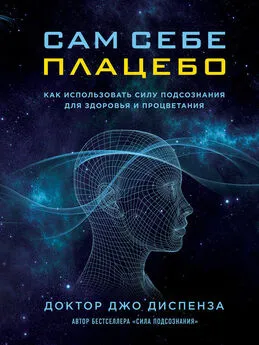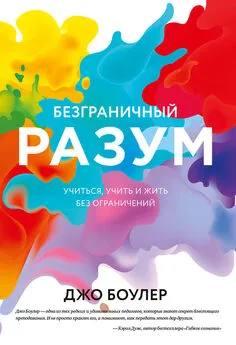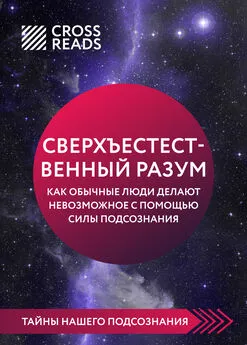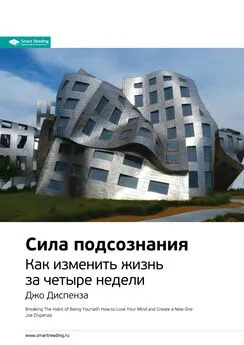Джо Диспенза - Сверхъестественный разум
- Название:Сверхъестественный разум
- Автор:
- Жанр:
- Издательство:Литагент 5 редакция
- Год:2017
- Город:Москва
- ISBN:978-5-04-089158-0
- Рейтинг:
- Избранное:Добавить в избранное
-
Отзывы:
-
Ваша оценка:
Джо Диспенза - Сверхъестественный разум краткое содержание
Применяя методы и техники новейших разработок в области эпигенетики, молекулярной биологии, нейрокардиологии и квантовой физики, до практических занятий, таких как медитация стоя и при ходьбе, доктор Джо Диспенза предлагает программу для выхода за пределы вашей физической реальности и вхождения в квантовое поле бесконечных возможностей.
Сверхъестественный разум - читать онлайн бесплатно ознакомительный отрывок
Интервал:
Закладка:
13. K. Umetani, D. Singer, R. McCraty, et al., “Twenty-Four Hour Time Domain Heart Rate Variability and Heart Rate: Relations to Age and Gender over Nine Decades.” Journal of the American College of Cardiology , vol. 31, no. 3: pp. 593–601 (March 1, 1998).
14. D. Childre, H. Martin, D. Rozman, and R. McCraty, Heart Intelligence: Connecting with the Intuitive Guidance of the Heart (Waterfront Digital Press, 2016), p. 76.
15. R. McCraty, M. Atkinson, W. A. Tiller, et al., “The Effects of Emotions on Short-Term Power Spectrum Analysis of Heart Rate Variability,” The American Journal of Cardiology , vol. 76, no. 14 (1995): pp. 1089–1093.
16. Pert, Molecules of Emotion .
17. Ibid.
18. Song, Schwartz, and Russek, “Heart-Focused Attention and Heart-Brain Synchronization.”
19. Childre, Martin, and Beech, The HeartMath Solution , p. 33.
20. Song, Schwartz, and Russek, “Heart-Focused Attention and Heart-Brain Synchronization.”
21. Childre, Martin, and Beech, The HeartMath Solution .
22. J. A. Armour, “Anatomy and Function of the Intrathoracic Neurons Regulating the Mammalian Heart, in I. H. Zucker and J. P. Gilmore, eds., Reflex Control of the Circulation (Boca Raton, FL: CRC Press), 1998.
23. O. G. Cameron, Visceral Sensory Neuroscience: Interoception (New York: Oxford University Press, 2002).
24. McCraty and Shaffer, “Heart Rate Variability: New Perspectives on Physiological Mechanisms, Assessment of Self-Regulatory Capacity, and Health Risk.”
25. H. Martin, “TEDxSantaCruz: Engaging the Intelligence of the Heart,” Cabrillo College Music Recital Hall, Aptos, CA, June 11, 2011, https://www.youtube.com/watch?v=A9kQBAH1nK4.
26. J. A. Armour, “Peripheral Autonomic Neuronal Interactions in Cardiac Regulation,” in J. A. Armour and J. L. Ardell, eds., Neurocardiology (New York: Oxford University Press, 1994), pp. 219—44; J. A. Armour, “Anatomy and Function of the Intrathoracic Neurons Regulating the Mammalian Heart,” in Zucker and Gilmore, eds., Reflex Control of the Circulation, pp. 1—37.
27. McCraty, Atkinson, Tomasino, and Bradley, “The Coherent Heart.”
1. E. Goldberg and L. D. Costa, “Hemisphere Differences in the Acquisition and Use of Descriptive Systems,” Brain Language , vol. 14, no. 1 (1981), pp. 144-73.
1. A. Aspect, P. Grangier, and G Roger, “Experimental Realization of Einstein-Podolsky-Rosen-Bohm Gedankenexperiment: A New Violation of Bell’s Inequalities,” Physical Review Letters , vol. 49, no. 2 (1982): 91–94; A. Aspect, J. Dalibard, and G. Roger, “Experimental Test of Bell's Inequalities Using Time-Varying Analyzers,” Physical Review Letters , vol. 49, no. 25 (9182): pp. 1804–1807; A. Aspect, “Quantum Mechanics: To Be or Not to Be Local,” Nature , vol. 446, no. 7138 (April 19, 2007): 866–867.
2. D. Bohm, Wholeness and the Implicate Order volume 135 (New York: Routledge, 2002).
3. I. Bentov, Stalking the Wild Pendulum: On the Mechanics of Consciousness (New York: E. P. Dutton, 1977); Ramtha, A Beginner's Guide to Creating Reality (Yelm, WA: JZK Publishing, 2005).
1. W. Pierpaoli, The Melatonin Miracle: Nature’s Age-Reversing, Disease-Fighting, Sex-Enhancing Hormone (New York: Pocket Books, 1996); R. Reiter and J. Robinson, Melatonin: Breakthrough Discoveries That Can Help You Combat Aging, Boost Your Immune System, Reduce Your Risk of Cancer and Heart Disease, Get a Better Night’s Sleep (New York: Bantam, 1996).
2. S. Baconnier, S. B. Lang, and R. Seze, “New Crystal in the Pineal Gland: Characterization and Potential Role in Electromechano-Transduction,” URSI General Assembly, Maastricht, Netherlands, August 2002.
3. R. Hardeland, R. J. Reiter, B. Poeggeler, and D. X. Tan, “The Significance of the Metabolism of the Neurohormone Melatonin: Antioxidative Protection and Formation of Bioactive Substances,” Neuroscience & Biobehavioral Reviews , vol. 17, no. 3: pp. 347—57 (Fall 1993); A. C. Rovescalli, N. Brunello, C. Franzetti, and G. Racagni, “Interaction of Putative Endogenous Tryptolines with the Hypothalamic Serotonergic System and Prolactin Secretion in Adult Male Rats,” Neuroendocrinology , vol. 43, no. 5: pp. 603—10 (1986); G. A. Smythe, M. W. Duncan, J. E. Bradshaw, and M. V. Nicholson, “Effects of 6-methoxy-1,2,3,4-tetrahydro-beta-carboline and yohimbine on hypothalamic monoamine status and pituitary hormone release in the rat,” Australian Journal of Biological Sciences, vol. 36, no. 4:379—86 (1983).
4. S. A. Barker, J. Borjigin, I. Lomnicka, R. Strassman, “LC/MS/MS Analysis of the Endogenous Dimethyltryptamine Hallucinogens, Their Precursors, and Major Metabolites in Rat Pineal Gland Microdialysate,” Biomedical Chromatography , vol. 27, no. 12: pp.1690–1700 (December 2013), doi: 10.1002/bmc.2981.
5. Hardeland, Reiter, Poeggeler, and Tan, “The Significance of the Metabolism of the Neurohormone Melatonin.”
6. David R. Hamilton, Why Kindness Is Good for You (London: Hay House UK, 2010) pp. 62–67.
7. R. Acher and J. Chauvet, “The Neurohypophysial Endocrine Regulatory Cascade: Precursors, Mediators, Receptors, and Effectors,” Frontiers in Neuroendocrinology , vol. 16: pp. 237–289 (July 1995).
8. D. Wilcox, “Understanding Sacred Geometry & the Pineal Gland Consciousness,” lecture available on YouTube at https://youtu.be/2S_m8AqJKs8?list=PLxAVg8IHlsUwwkHcg5MopMjrec7Pxqzhi.
1. Global Union of Scientists for Peace, “Defusing World Crises: A Scientific Approach.”
2. Ibid.
3. D. W. Orme-Johnson, C. N. Alexander, J. L. Davies, et al., “International Peace Project in the Middle East: The Effects of the Maharishi Technology of the Unified Field,” Journal of Conflict Resolution , vol. 32, no. 4 (December 4, 1988).
4. D. W. Orme-Johnson, M. C. Dillbeck, and C. N. Alexander, “Preventing Terrorism and International Conflict: Effects of Large Assemblies of Participants in the Transcendental Meditation and TM-Sidhi Programs,” Journal of Offender Rehabilitation , vol. 36, no.1–4: pp. 283–302 (2003).
5. “Global Peace – End of the Cold War,” Global Peace Initiative, http://globalpeaceproject.net/proven-results/case-studies/global-peace-end-of-the-cold-war/.
6. J. S. Hagelin, M. V. Rainforth, K. L. C. Cavanaugh, et al., “Effects of Group Practice of Transcendental Meditation Program on Preventing Violent Crime in Washington, D.C.: Results of the National Demonstration Project, June – July 1993,” Social Indicators Research , vol. 47, no. 2: pp. 153–201 (June 1999).
7. R. D. Nelson, “Coherent Consciousness and Reduced Randomness: Correlations on September 11, 2001,” Journal of Scientific Exploration , vol. 16, no. 4; pp. 549—70 (2002).
8. “What Are Sunspots?” Space.com, http://www.space.com/14736-sunspots-sun-spots-explained.html (February 29, 2012).
9. A. L. Tchijevsky (V. P. de Smitt trans.), “Physical Factors of the Historical Process.” Cycles , vol. 22: pp. 11–27 (January 1971).
10. S. Ertel, “Cosmophysical Correlations of Creative Activity in Cultural History.” Biophysics , vol. 43, no. 4: pp. 696–702 (1998).
11. C. W. Adams, The Science of Truth (Wilmington, DE: Sacred Earth Publishing, 2012), p. 241.
12. “Earth’s Atmospheric Layers,” (January 21, 2013), https://www.nasa.gov/mission_pages/sunearth/science/atmosphere-layers2.html.
13. R. Wever, “The Effects of Electric Fields on Circadian Rhythmicity in Men,” Life Sciences in Space Research , vol. 8: pp. 177—87 (1970).
14. Iona Miller, “Schumann Resonance,” Nexus Magazine , vol. 10, no. 3 (April – May 2003).
15. Childre, Martin, Rozman, and McCraty, “Heart Intelligence: Connecting with the Intuitive Guidance of the Heart.”
16. R. McCraty, “The Energetic Heart: Bioelectromagnetic Communication Within and Between People, in Bioelectromagnetic and Subtle Energy Medicine,” in P. J. Rosch and M. S. Markov, eds., Clinical Applications of Bioelectromagnetic Medicine (New York: Marcel Dekker, 2004).
17. Childre, Martin, Rozman, and McCraty, “Heart Intelligence: Connecting with the Intuitive Guidance of the Heart.”
18. R. McCraty, “The Global Coherence Initiative: Measuring Human-Earth Energetic Interactions,” Heart as King of Organs Conference, Hofuf, Saudi Arabia (2010); R. McCraty, A. Deyhle, and D. Childre, “The Global Coherence Initiative: Creating a Coherent Planetary Standing Wave,” Global Advances in Health and Medicine, 1 (1): p. 64–77 (2012); R. McCraty, “The Energetic Heart,” in Clinical Applications of Bioelectromagnetic Medicine.
19. HeartMath Institute, “Global Coherence Research,” https://www.heartmath.org/research/global-coherence/.
20. S. M. Morris, “Facilitating Collective Coherence: Group Effects on Heart Rate Variability Coherence and Heart Rhythm Synchronization,” Alternative Therapies in Health and Medicine , vol. 16, no. 4: pp. 62–72 (July – August 2010).
21. K. G. Korotkov, Energy Fields Electrophotonic Analysis in Humans and Nature: Electrophotonic Analysis , 2nd edition (CreateSpace Independent Publishing Platform, 2014).
22. D. Radin, J. Stone, E. Levine, et al., “Compassionate Intention as a Therapeutic Intervention by Partners of Cancer Patients: Effects of Distant Intention of the Patients’ Autonomic Nervous System,” Explore , vol. 4, no. 4 (July – August 2008).
Вклейка
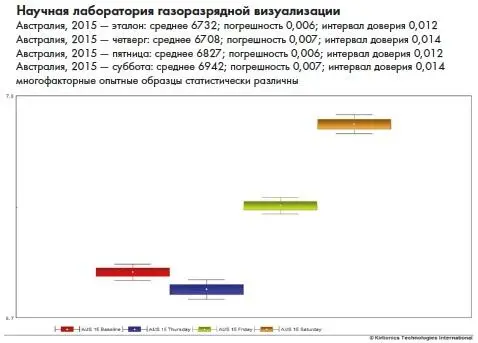
Иллюстрация 1А
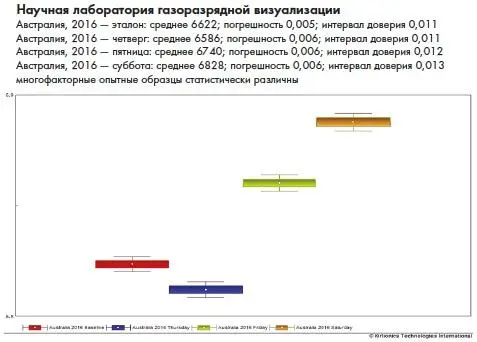
Иллюстрация 1B
На некоторых из наших продвинутых семинаров, когда студенты разрывают энергетические связи со всеми людьми и явлениями из их прошло-настоящей реальности, они берут энергию из окружающего поля, чтобы построить свое собственное электромагнитное поле. Когда такое происходит, уровень энергии в комнате может упасть. Оба рисунка демонстрируют это явление в ходе двух продвинутых семинаров, проходивших в Австралии в 2015 и 2016 годах. Красная линия представляет базовый замер, проведенный в среду – день, предварявший начало мероприятия, когда в комнате никого не было. Синяя линия обозначает четверг – первый полный день семинара. Вы видите, что уровень энергии в комнате слегка понизился. Зеленая линия обозначает пятницу – второй день семинара. Вы видите, как уровень энергии в комнате продолжает возрастать по мере того, как студенты продвигаются в своих пятничных занятиях. В этой точке, вместо того чтобы брать энергию из поля, они вкладывают энергию в поле.
Читать дальшеИнтервал:
Закладка:
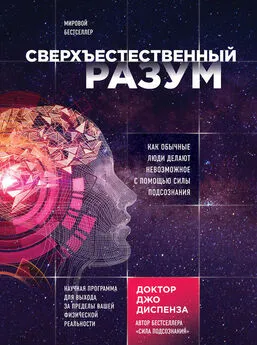

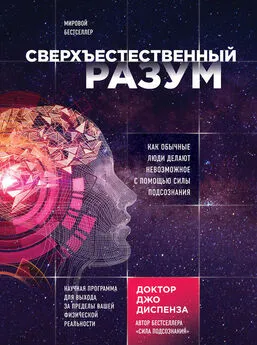

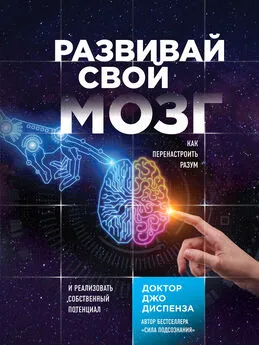
![Джо Холдеман - Мост к разуму [сборник]](/books/1069898/dzho-holdeman-most-k-razumu-sbornik.webp)
